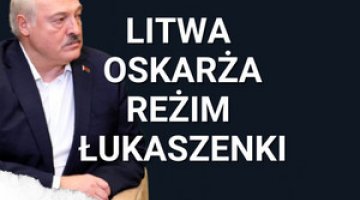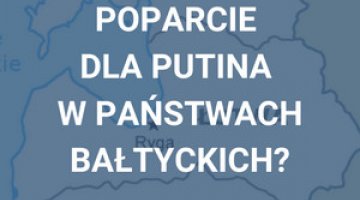Lithuania – the political crisis after the elections
Algirdas Butkevicius, the leader of the Social Democrats who won the parliamentary elections which ended on 28 October, has undertaken a mission to form the government. As he had promised, he commenced talks with the Labour Party and the Order and Justice party, two populist groupings which are currently referred to in Lithuania as centrist.President Dalia Grybauskaite unexpectedly intervened in the coalition forming process. She stated that she would only back a new government coalition on condition that it did not include the Labour Party, which – like its leader, Viktor Uspaskich – had been charged by public prosecution authorities with embezzlement of funds. Grybauskaite has also accused this party of buying votes on a massive scale. This stance brought about a political crisis over the formation of the government coalition after the election. Since the Social Democrats were opposed to the exclusion of the Labour Party from the coalition, Grybauskaite decided to call into question the legality of the election. On 7 November, she brought a motion to the Constitutional Court to determine whether the constitution had been violated during the election. A similar resolution was passed by the Seimas, the unicameral parliament where right-wing parties predominate, shortly before the end of its term. It is difficult to predict at present how the crisis situation will ultimately be resolved. Various scenarios are possible: from concessions being made by one of the sides to holding early elections, in the event that the Court finds that mass violations have taken place. Invalidation of the election would be unprecedented and there are no legal acts to regulate a situation like this It is therefore unclear who – the president or the pre-election composition of the Seimas – would take power in the country until a new election is held.
The escalation of the crisis
The parliamentary runoff merely caused a reshuffle inside the leaders’ group (see Appendix 1). The Social Democrats won the election whereas the Homeland Union (conservatives)/Christian Democrats, the right-wing party which had been governing the country for the last four years, received the second highest support and will go into opposition. The third best result was achieved by the populist Labour Party, led by Viktor Uspaskich, an ethnic Russian, who had triumphed in the first round. The coalition of the left-wing and populist parties, which the leader of Social Democrats, Algirdas Butkevicius, has undertaken to form, will have 78 of the 141 seats in the Seimas. The proposal to withdraw Labour Party candidates who had been linked to the embezzlement case from senior positions, including Uspaskich himself, was rejected by the president. Grybauskaite stated that she also had reservations regarding some of the Social Democrats. The dispute was aggravated when the coalition partners invited the Polish party AWPL (this is the first time when it will be able to form its own parliamentary faction owing to the eight seats it has won, see Appendix 2) to embark on talks aimed at enhancing the post-election alliance. The participation of the AWPL would give a new coalition the constitutional majority of three fifths of the seats in parliament. Article 74 of the constitution grants a three-fifths a 60% majority of MPs the power to impeach the president and any other senior officials for breaking the constitutional oath or breaching the constitution, which the president has been accused of having committed. One pretext for such an allegation against her can be provided by her current blocking of the Labour Party as a coalition partner in a situation where no court judgement confirming the existence of irregularities in the party’s finances has been passed. Pursuant to Lithuanian legislation, if the Labour Party has been allowed to take part in the election, it cannot be eliminated from the government coalition on the grounds of the public prosecutor’s charges alone, until a court judgement has been passed. The Labour Party has also used the argument that the Lithuanian public are perfectly familiar with the allegations brought against this party and its leader, and yet they still vote for them.
The Supreme Electoral Commission has recognised the result of the election, although some violations and cases of vote buying had been recorded. Its chairman, Zenonas Vaigauskas, is claiming that they did not occur on a massive scale. However, President Grybauskaite is not the only person who holds the opposite opinion – the signatories of the Act of Independence of Lithuania of 11 March 1990 and university students are actively protesting against recognition of the election. Due to violations in one of the constituencies during the first round, the Court cancelled the election result following a motion from the president. Grybauskaite brought another motion to the Court and refused to take part in the coalition forming process until the judgement was announced (it is expected on 10 November). Although the matter is still to be considered by the Constitutional Court, the coalition partners have already signed an agreement and divided the positions among themselves. The Social Democrats will have their prime minister and the ministers of Finance, Foreign Affairs, Defence, Transport, Economy, Health and Justice. The Labour Party will be in charge of Agriculture, Education & Science, Social Welfare, Labour, Culture and Internal Affairs. A candidate from the Labour Party will become the speaker of the Seimas and deputy prime minister. Order and Justice will be in charge of the Ministries for Environment Protection and Energy. The AWPL has not embarked on direct coalition negotiations as yet. The coalition partners have not withdrawn their offer to this party; in fact the Labour Party is even ready to put AWPL in charge of the Ministry of Culture. This would undoubtedly irritate the right-wing opposition, no less than the previous declaration from the Polish party of its desire to lead the Ministry of Education and Science.
The motivations of the two parties in the dispute
President Grybauskaite has been making efforts to break the alliance of the left-wing and populist parties being forged and to lead to the formation of a grand coalition of Social Democrats and Conservatives/Christian Democrats. Unsuccessful attempts to bring these parties into closer co-operation were also made in the past by the then President Valdas Adamkus. He thus wanted to reverse the consequences of the political ‘pendulum’ principle operating in Lithuania since the country regained independence. According to this principle, voters’ sympathies regularly swing between the left and the right wing of the political scene, impeding the continuation of various political and economic processes in the country. This also often means a revolution in these areas. One example is the project to build a new nuclear power plant, which was initiated by the left and contested by the right. When the right took power, they cancelled all the decisions which had been taken in connection with this project and proposed their own model. This in turn is unacceptable to the Social Democrats, who are presently taking power.
The right wing are determined to keep power and so are ready to co-operate with the left. The Social Democrats are unwilling to enter into any such alliance. Co-governing the country with the party whose policy they have been contesting for four years could undermine their image in the eyes of the Lithuanian public, who cast their votes in the belief that the alliance of the left and populists would remove the conservative government of Andrius Kubilius from power.
For Grybauskaite this conflict also marks the beginning of her own struggle for staying in office after the next election (scheduled for 2014). When she was seeking election for the first time, she was an independent candidate. Initially, she had been promoted by the political left, but during the presidential election she received stronger support from the right. In foreign policy, which the Lithuanian president co-creates, Grybauskaite has failed to bring about a warming of relations, contrary to Moscow’s expectations. Instead, she totally backed the uncompromising policy adopted by the conservative government in its dealings with Russia. It should be expected that in the next campaign she will receive the strongest political support from the Conservatives/Christian Democrats, who will be in opposition. It is in her interest to maintain the alliance with them. One method for convincing the Lithuanian public to vote for her is by upholding their belief that only the political right and Grybauskaite as president are able to withstand the pressure from Russian politics and Russian business, which seek to keep the Baltic states within the Russian area of influence.
Appendix 1
Table of results in the two rounds of the elections
|
Party |
first round (14 October) |
runoff (28 October) |
total |
|
Lithuanian Social Democratic Party |
16 |
22 |
38 |
|
Homeland Union/Christian Democrats |
13 |
20 |
33 |
|
Labour Party |
18 |
11 |
29 |
|
Order and Justice |
6 |
5 |
11 |
|
Liberal Movement |
7 |
3 |
10 |
|
Electoral Action of Poles in Lithuania |
6 |
2 |
8 |
|
The Way of Courage |
7 |
0 |
7 |
|
Peasant and Greens Union |
0 |
1 |
1 |
|
Independent candidates |
0 |
3 |
3 |
One seat is vacant. After the first round, the Constitutional Court cancelled the result in the Zarasai-Visaginas constituency due to violations of election rules. Voting will be re-held in this constituency within six months from the completion of both rounds of the election. Until then, the Seimas will consist of 140 MPs.
Appendix 2
AWPL in the election
In the runoff, the Polish party did not manage to mobilise once again those voters whose active engagement allowed it to cross the 5-percent electoral threshold for the first time in the (proportional representation) election. This party gained five seats from the party list and one in a single-member constituency during the first round. The AWPL’s list in the first round included members of two other groupings, one of the two parties representing the Russian minority and the Lithuanian People’s Party, led by the former prime minister Kazimira Prunskiene. None of the candidates from the parties backing the AWPL won a seat in the first round (voters were able to mark their preferences on the party list). The electorate of these parties could have felt disappointed about their votes having been wasted. In the runoff, Poles were set to be the leaders in three single-member constituencies and were ranked second in three others. The voting result turned out worse than expected. The party finally won only two seats due to lower turnout. However, the AWPL will be able to form its own faction (a minimum of seven MPs is required). Following the promise the AWPL made to its partners during the election, it will relinquish one seat to a candidate from the Russian party. The results achieved by the AWPL indicate that, in order to exist on the Lithuanian political scene as a significant parliamentary force, the Polish party must consider extending its electorate to include people who vote not only in the regions where ethnic Poles predominate and not only in the interest of the Polish minority.
At present, it is still an open question whether the AWPL will take part in the government coalition. The party’s leader, Waldemar Tomaszewski, has demonstrated readiness to participate from the very beginning. He even caused confusion among his voters by declaring that he would not raise the issue of Polish name spelling at the political level. He neutralised the impression that part of the Polish minority’s demands would be sacrificed at the expense of the AWPL’s participation in the government by offering the coalition partners de facto unacceptable conditions. He insisted that the AWPL should be put in charge of the Ministry of Education and Science and three other ministries in which the other coalition members were also interested, including the Ministry of Economy. Finally, the AWPL’s expectations were reduced to the same number of ministries (two) as offered to Order and Justice. The announcement that the AWPL could join the government coalition provoked another attack against this party from the political right. This is inherent in the rhetoric, according to which Russian influence will grow in Lithuania if the political right is removed from power. The right-wing parties have been recently capitalising on the issue of contacts and co-operation with some AWPL members, including Waldemar Tomaszewski, with Russian organisations and media backed by the Kremlin and the Russian embassy. Although Tomaszewski himself claims that these have been normal relations, the Lithuanian media which support the political right, are speculating that the idea to become election partners not only with ethnic Russians but also with the openly pro-Russian People’s Party led by Kazimira Prunskiene was conceived during such contacts.





